Shopify is widely considered one of the best ecommerce platforms around – but building a successful store isn’t as simple as it might seem.
With over 5.2 million Shopify stores worldwide, it has never been more important to stand out from the competition and optimize your online store for search engines.
So how can you go about implementing the best Shopify SEO practices? And how does the platform support you in search engine optimization?
In this Shopify SEO guide, we'll be giving you 10 steps for SEO success, so you can improve your search engine rankings and see your sales skyrocket in no time.
How to improve your Shopify SEO
If you feel like you're battling against search engine results pages, you've come to the right place. But as well as optimizing your store for search engines, we'll also be talking through how Shopify SEO and user experience go hand in hand.
Whether you're new to SEO, or you've already dipped your toe in — we'll be covering Shopify SEO basics as well as more advanced elements to optimize.
Ready to get started? Follow the 10 steps below to crack SEO for Shopify:
Step 1: Optimize your site structure
It's important to keep any website organized. But when it comes to an ecommerce site, keeping your content structure tidy is crucial for SEO success.
When shoppers visit your store, they need to be able to navigate their way around easily – if they can't, they'll likely go elsewhere. The more time you can get users to spend on your website, the higher the chance of them browsing more pages, which can boost your search engine rankings.
But what does that really mean? Organizing your Shopify store doesn't mean chucking all your products onto one page. Instead, keep categories and sub-categories simple.
Not only does simplifying your product pages make it easier for shoppers to navigate their way around, but it also makes it easier for search engines to crawl (and rank) your online store.
Optimizing your Shopify store and keeping a logical site structure goes beyond organizing your categories. There are other website structure elements to consider, including:
- Your homepage — This often serves as the main entry point, so it's important to make a great first impression and direct shoppers to key pages from here
- Navigation menu — A clear and organized navigation menu makes a huge difference to your Shopify store, helping users find what they're looking for easily and quickly
- Individual pages — Whether your blog page, about page or specific collection pages, make the most of these pages and feature your target keywords where possible
- Contextual links — Different to your main navigation menu, contextual links enhance content organization, improve how search engines index your Shopify store and help users explore your site
Step 2: Improve user experience
When it comes to user experience, there are numerous factors that need to be considered. As we mentioned above, your navigation and site structure is incredibly important. If users can't find their way around your Shopify store, they're going to leave.
Imagine walking into the mall and there being no clear signage on where to go, you'd likely get fed up and head back out again.
When shoppers do this online, not only does this severely affect your bounce rate, but it can lead to frustration. When this happens, they're unlikely to return.
But what steps can you take to improve your Shopify site's user experience?
Use a responsive design
Using a responsive design for your Shopify website ensures that it adapts to the device it's being viewed on. In recent years, smartphones have accounted for almost 80% of all visits to retail websites, surpassing orders from desktops and tablets. Therefore, having a website that is easy to use on a mobile is essential.
But no matter whether your shoppers are browsing on a desktop or scrolling on their phone, your store needs to look great and respond accordingly.
Since search engines pay close attention to time on page, having a site that is easy to navigate across any device is a no-brainer. No matter what style of Shopify site, the platform has a variety of templates available to choose from.
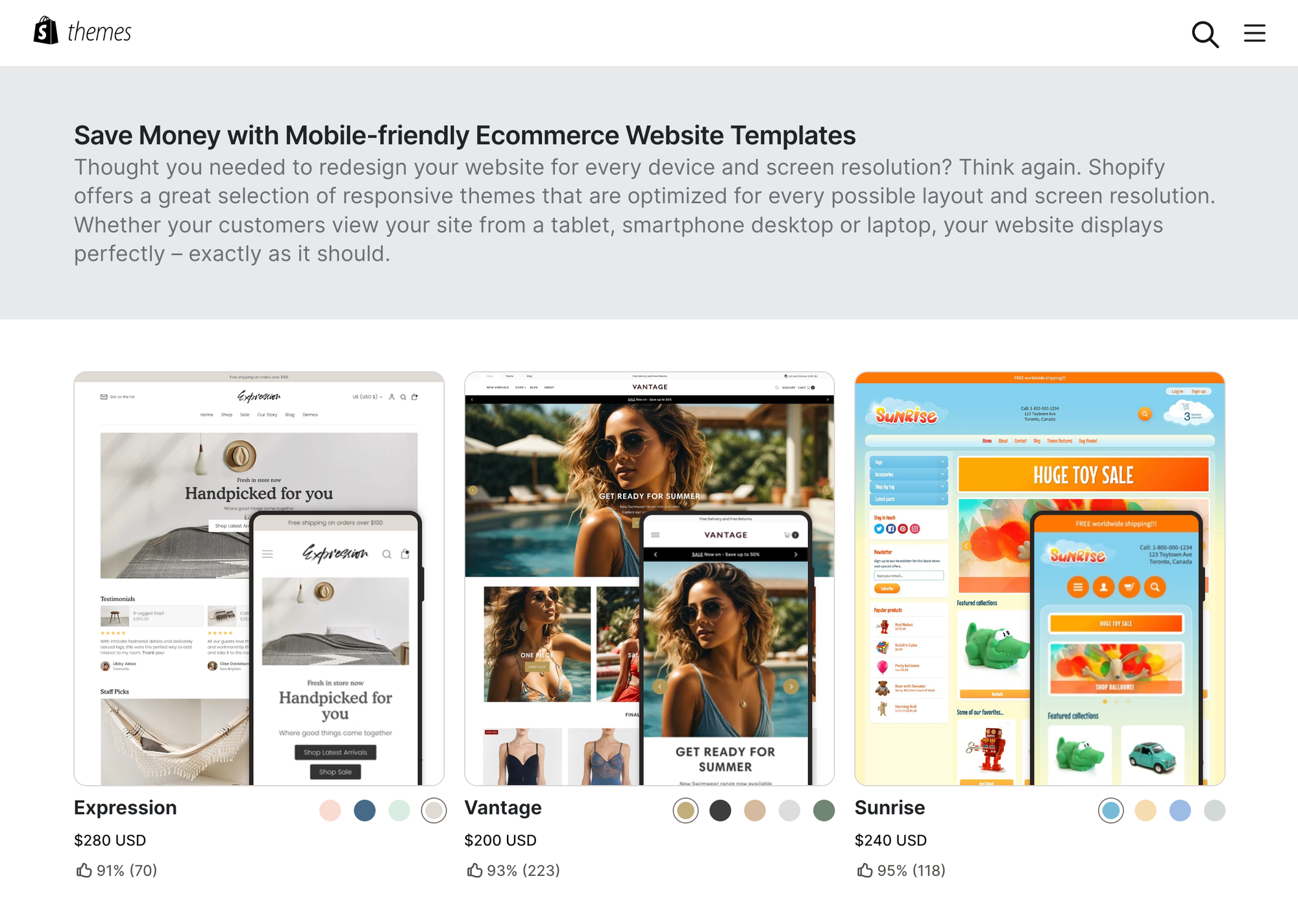
Optimize page speed
We all want a quick and seamless experience when shopping online. There's nothing worse than a website that lags, takes you in the wrong direction or isn't easy to navigate.
To make your Shopify store perform well (both for users and search engines), try the following:
- Choose a theme wisely — Ensure it is lightweight and mobile-friendly
- Optimize images — Before uploading, resize and optimize images for a quicker load time
- Do some housekeeping — Remove any unnecessary apps to keep things running smoothly
- Avoid sliders — Although tempting to use, widgets such as sliders can be slow to load
Not sure which ecommerce site to use? Find out what Shopify is capable of and how it works in our easy guide.
Step 3: Do keyword research
The foundation of every successful Shopify SEO strategy — doing keyword research cannot be ignored.
To get started, try to put yourself in your customers' shoes. How would they find your products? Start by making a list of the five main topics that are closely related to what you sell.
Think about what questions your customers may have, and answer those accordingly.
Let's say you sell sneakers online — think about what would inform their decision, and what information they need to know.
For example:
- The basics, such as size, color, material and price
- A description of the product
- High-quality, optimized images
- Reviews
- Delivery/return information
- Alternatives/similar items
If you're struggling to gather five main topics, look for inspiration from places like:
- Forums and social media groups related to your products
- Social media hashtags
- Competing websites of similar brands, paying close attention to their content, titles and meta descriptions
To help find your target keywords, there are several free and paid SEO tools you can use, including:
Ahrefs
Ahrefs is an excellent tool for keyword research. You can even use AI to suggest keywords related to your topic if you're stuck for ideas.
Start by popping in a top-level keyword into Keyword Explorer, before narrowing it down further.
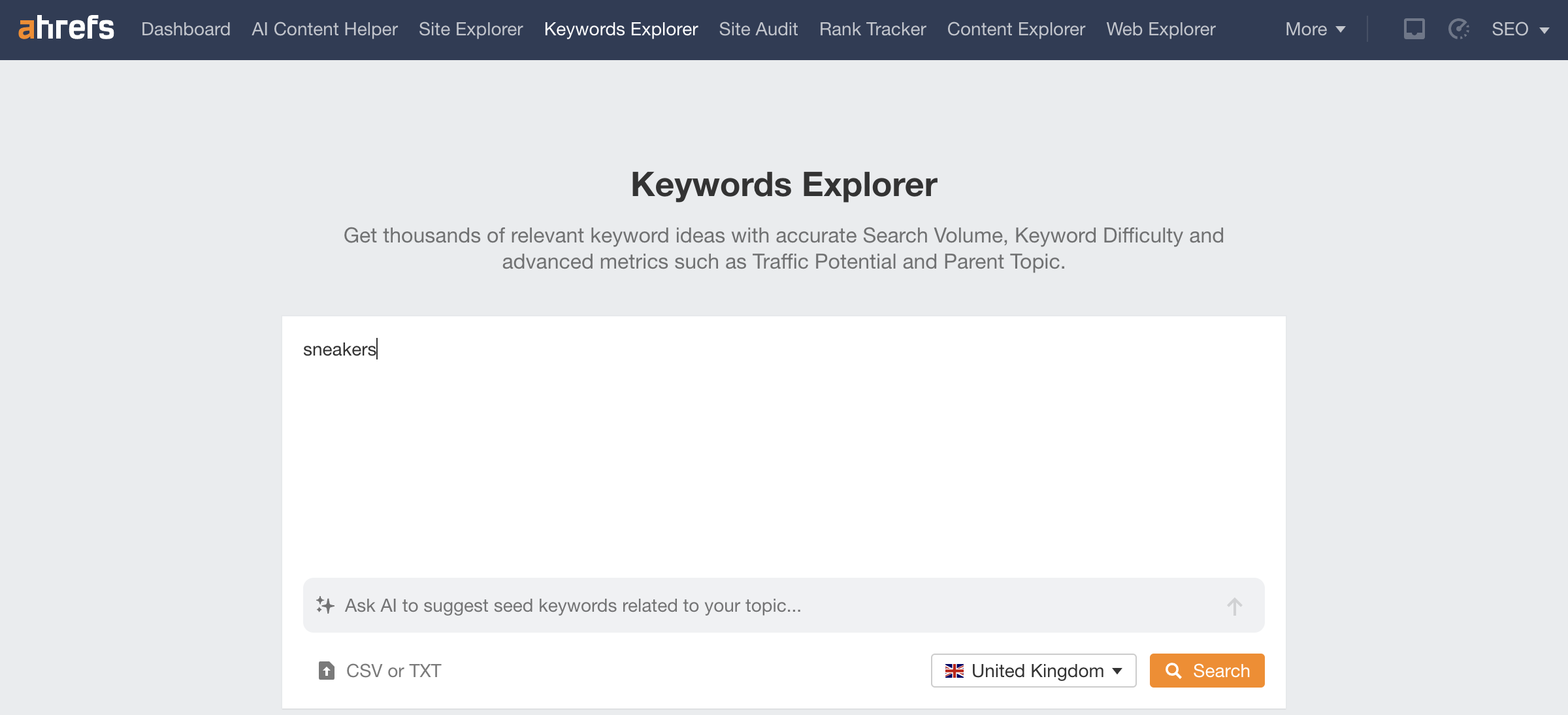
Once you've made your search, you'll be met with thousands of keyword matches, as well as questions related to your keyword and their search volume.
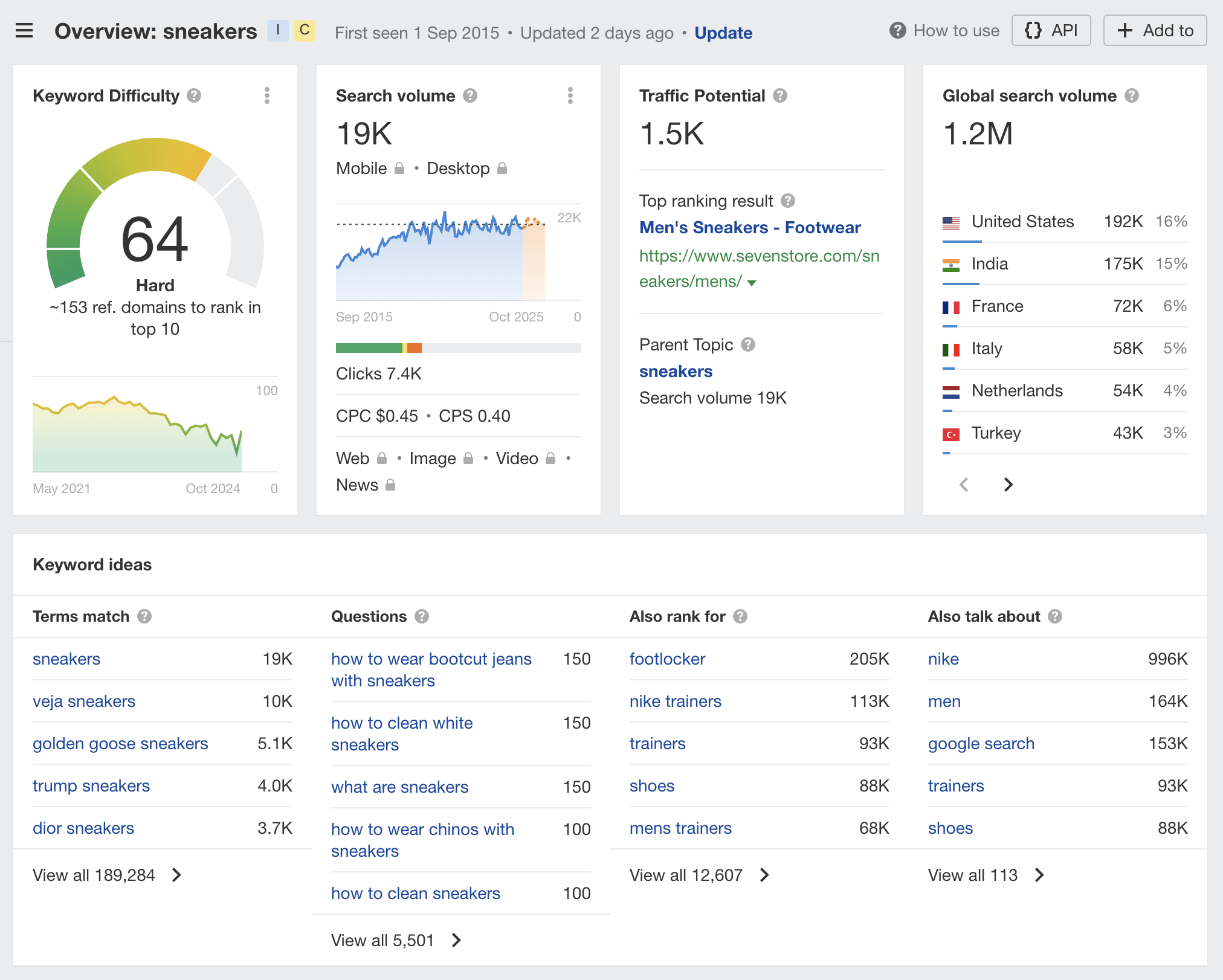
Looking for another alternative to Ahrefs? Take a look at how Semrush compares as we put the two head-to-head.
Ubersuggest
Ubersuggest is a great tool to help optimize your Shopify SEO. In a similar way to Ahrefs, you'll be met with a bunch of impressive data after making a search.
If your Shopify store only operates in a specific location, their location breakdown can be a great way to see what users are searching for according to where they are.
Yet again, you'll also receive suggestions for other keywords, as well as questions and prepositions.
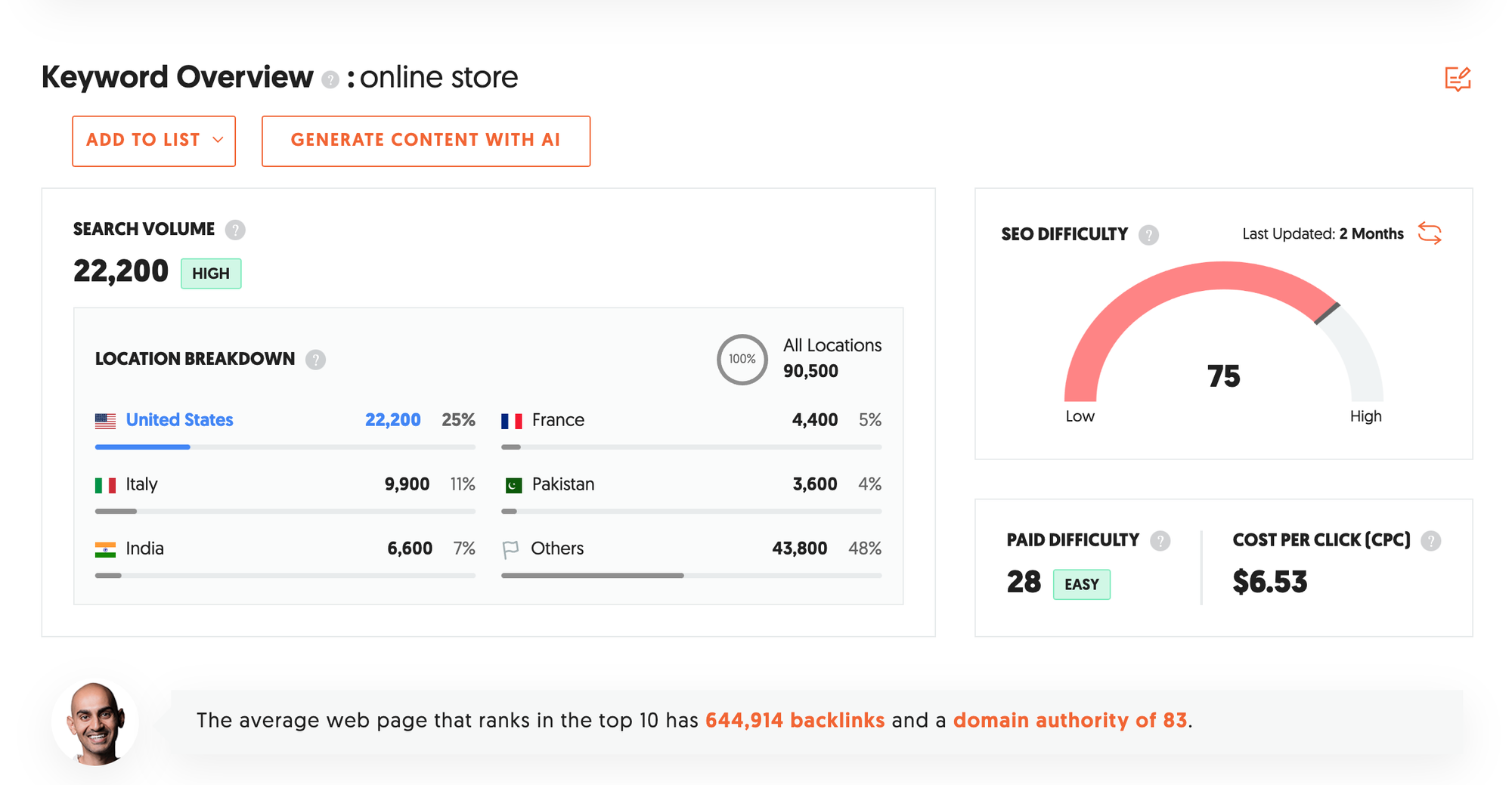
Google Search Console
Formerly known as Google Webmaster Tools, Google Search Console is easily one of the best places to carry out keyword research. This free SEO tool allows you to:
- Track your target keywords
- See the queries your store is ranking for
- Optimize your Shopify store's visibility in Google search engine results pages
- Review indexed pages
- See where your users are located
- Understand what devices your users are browsing on

Already a Whop seller? Here’s how to create a Google Analytics account for your Whop and make the most of powerful data.
Things to consider when doing keyword research:
- How competitive each keyword is
- The relevance of keywords to both your products and target audience
- Which keywords are most likely to result in conversions
- Search intent
Ways to use your target keywords:
Adding target keywords to your Shopify store goes beyond featuring them in product descriptions. To nail your Shopify SEO, it's important to use these terms elsewhere — without overdoing it (known as keyword stuffing).
Make sure you are featuring relevant keywords in other areas, such as:
- Meta descriptions
- Alt text
- Title tags
- On category pages
But don't worry, we're going to talk about metadata in greater depth a little later.
Step 4: Optimize your product pages
Search engines are clever beasts, but it's not all about search results – it's important to remember your shoppers are real people, not an algorithm.
When setting up your Shopify store, pay close attention to how successful competitors are displaying their information. Start with your top pages first, these will likely be your homepage and main product page collections.
For a great example of an impactful homepage, take a peek below at how the Shopify site Allbirds gets customers excited to buy.
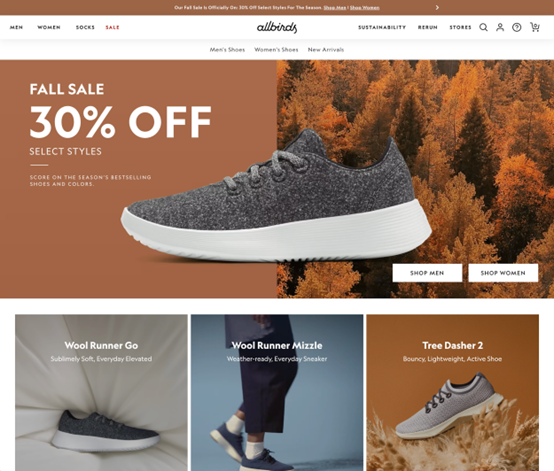
As we mentioned earlier, try to include all the relevant information on your product pages, such as size, color, etc.
Next, move on to how you plan to use your target keywords consistently across title tags. For example:
- Keyword 1 | Shop for Keyword 2 | Name of Store
- Black Jackets | Shop for Black Jackets Online | Name of Store
How to optimise product titles and meta descriptions
While it might be tempting to ask AI to write your product titles and meta descriptions, search engines will value original content.
When adding each target keyword to your copy, your content should flow naturally. If it sounds clunky or unnatural, not only will shoppers be confused, but search engines will be too.
Don't forget, alt text for your images can be a part of your Shopify SEO strategy. This short description of an image is designed for screen readers, but can also help search engines understand your images better.
Feeling unsure how to get started with writing meta descriptions?
Step 5: Build backlinks
Search engines examine backlinks to understand how other websites value yours. It's a little like receiving a recommendation online — backlinks improve SEO by bringing greater visibility to your site.
Think of it this way, if a well-known blogger were to feature your store, search engines would stand up and pay attention to their recommendation since they already have authority online.
Online visibility is crucial for bringing your site up results pages, but how can you build backlinks?
- Speak to suppliers and manufacturers — If you sell products made or supplied by established companies, they may have an option to get a link from them.
- Reach out to influencers and industry experts — This can generate both links back to your website and bring organic traffic to your store by featuring them in your blog content.
- Create blog posts that others will find informative — This can lead to natural link building and also improve how your desired keywords are used across your website.
Step 6: Work on your content marketing
Now that you have the other elements of Shopify SEO in place, there's something else we'd like to uncover to boost those all-important search results — content marketing.
Yep, we've all heard that 'content is king', right? As an ecommerce store owner, it's easy to think that covering the basics is enough, such as:
- Writing a meta description for each product
- Product descriptions
- A well-structured navigation
For greater success with your Shopify SEO, you're going to want to take advantage of content marketing. To get started, think about adding an FAQ to your website. This could cover things like:
- Sizing guide
- Shipping and returns information
- Sustainability around your brand
However, not every piece of content marketing needs to be packed with promotional content. This is an opportunity to allow customers to get to know your brand – without pushing products on them. Plus, it's a great way to increase organic traffic and naturally build backlinks.
See how Helm Boots uses their 'Story' section to include search terms in their content and follow a new line of search intent. Not only is this a great way to offer value to customers, but search engines love it too.
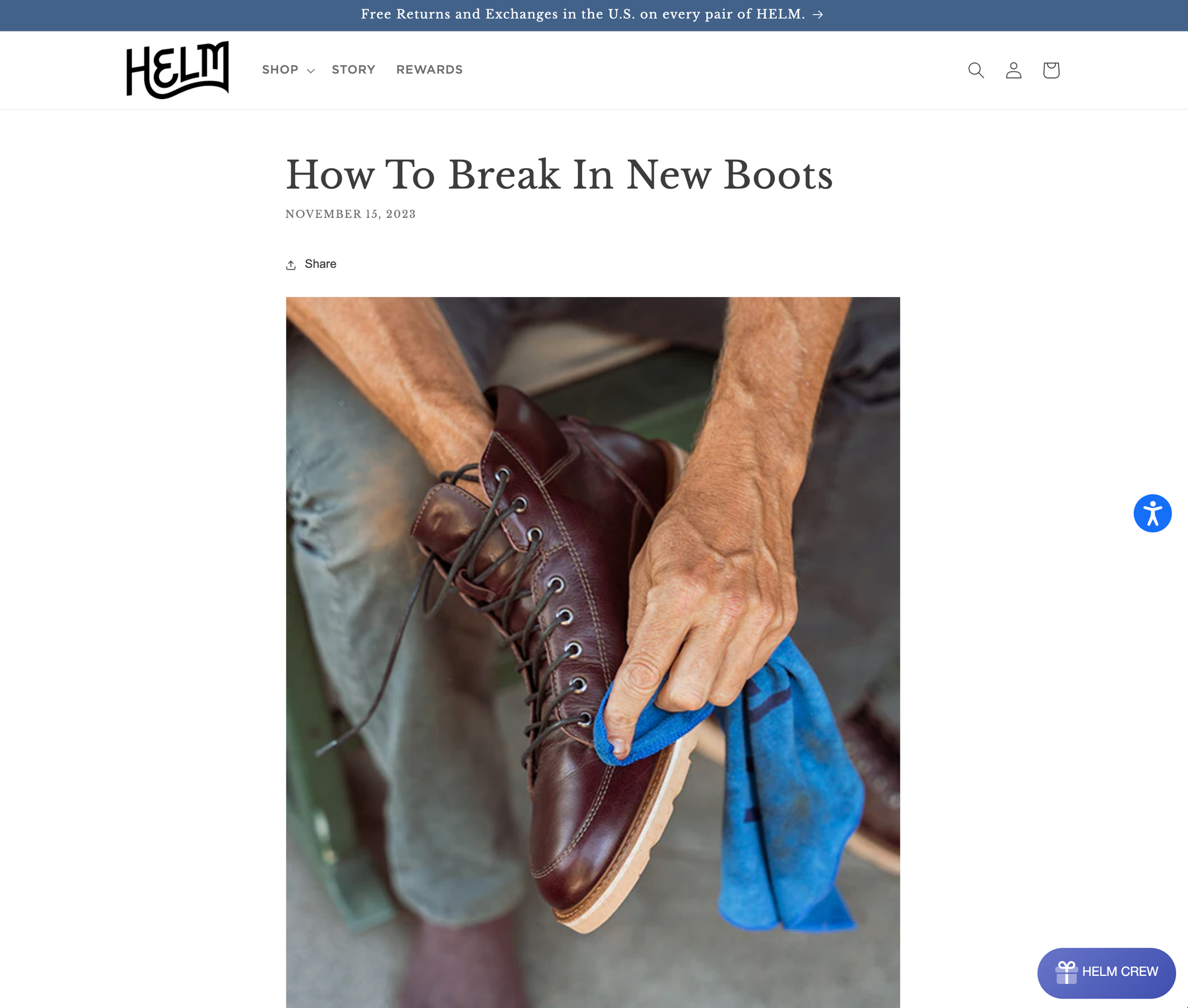
Don't know how to get started? Discover what commerce content really is and how it's working for brands already.
Step 7: Use the best Shopify SEO apps and tools
On-page SEO plays an important role in your Shopify SEO. Many Shopify websites make the most of in-built SEO tools and apps, including:
SEO King
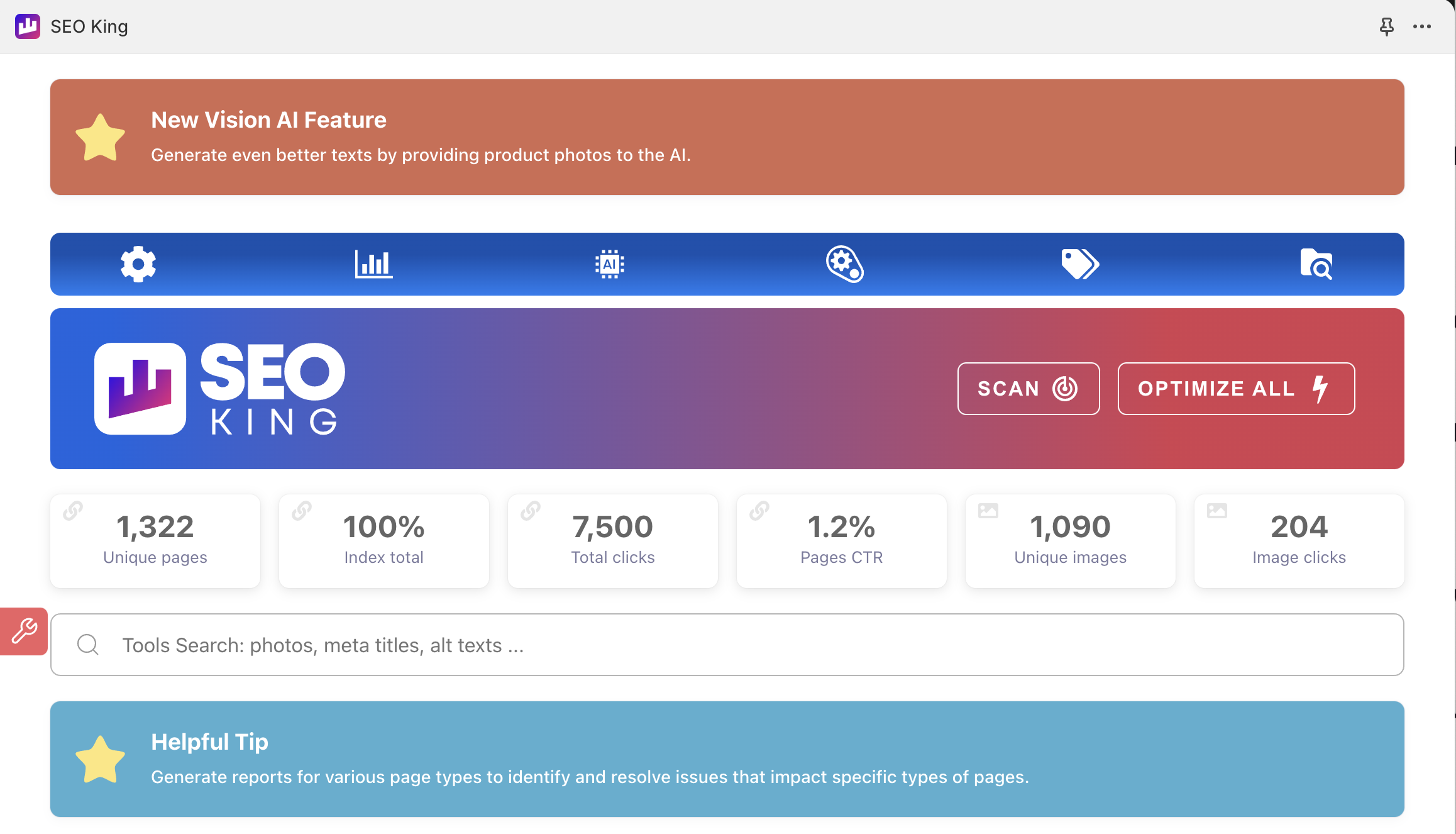
SEO King incorporates AI tools to help you overcome your SEO challenges. This includes saving you time with a bulk editor for alt text, meta title tags and descriptions.
The app integrates well with Google Search Console as well, so you can analyze your data with ease. As we mentioned earlier, optimizing images is key for site speed — so you'll be pleased to hear that SEO King can handle this for you.
They even have a free plan, so you can try it before you choose to sign up for one of their subscription plans.
Bloggle
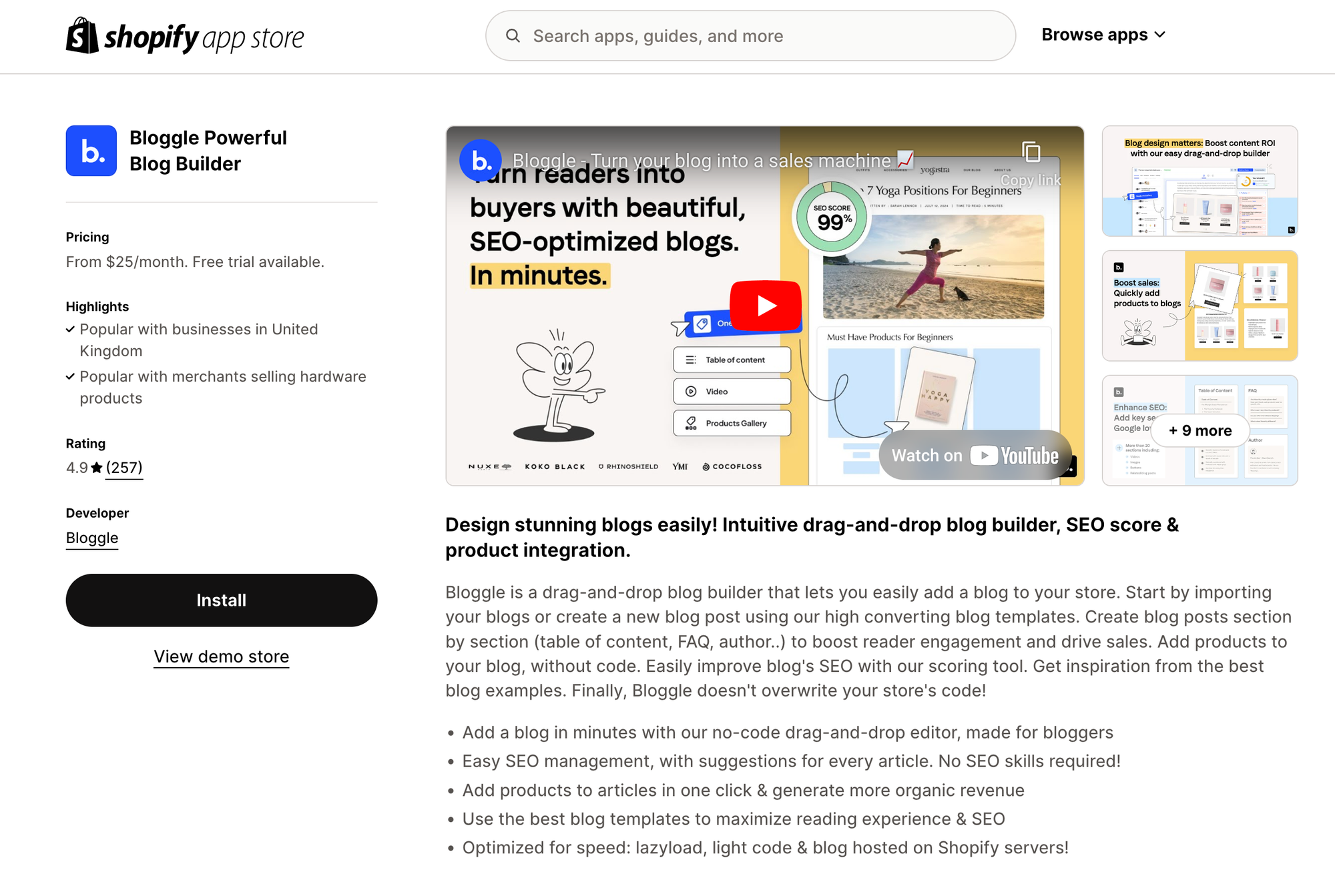
Another great tool from Shopify. Bloggle is a powerful blog builder that helps you to increase your site's SEO performance and internal links via a blog. It's a pretty easy drag-and-drop builder, so you don't have to be a web design expert to get started.
If you're new to on-page SEO, you'll feel at home with the app's SEO suggestions for every blog post you add. It also has lazyload and light code — so your site speed won't be affected.
Booster SEO & Image Optimizer
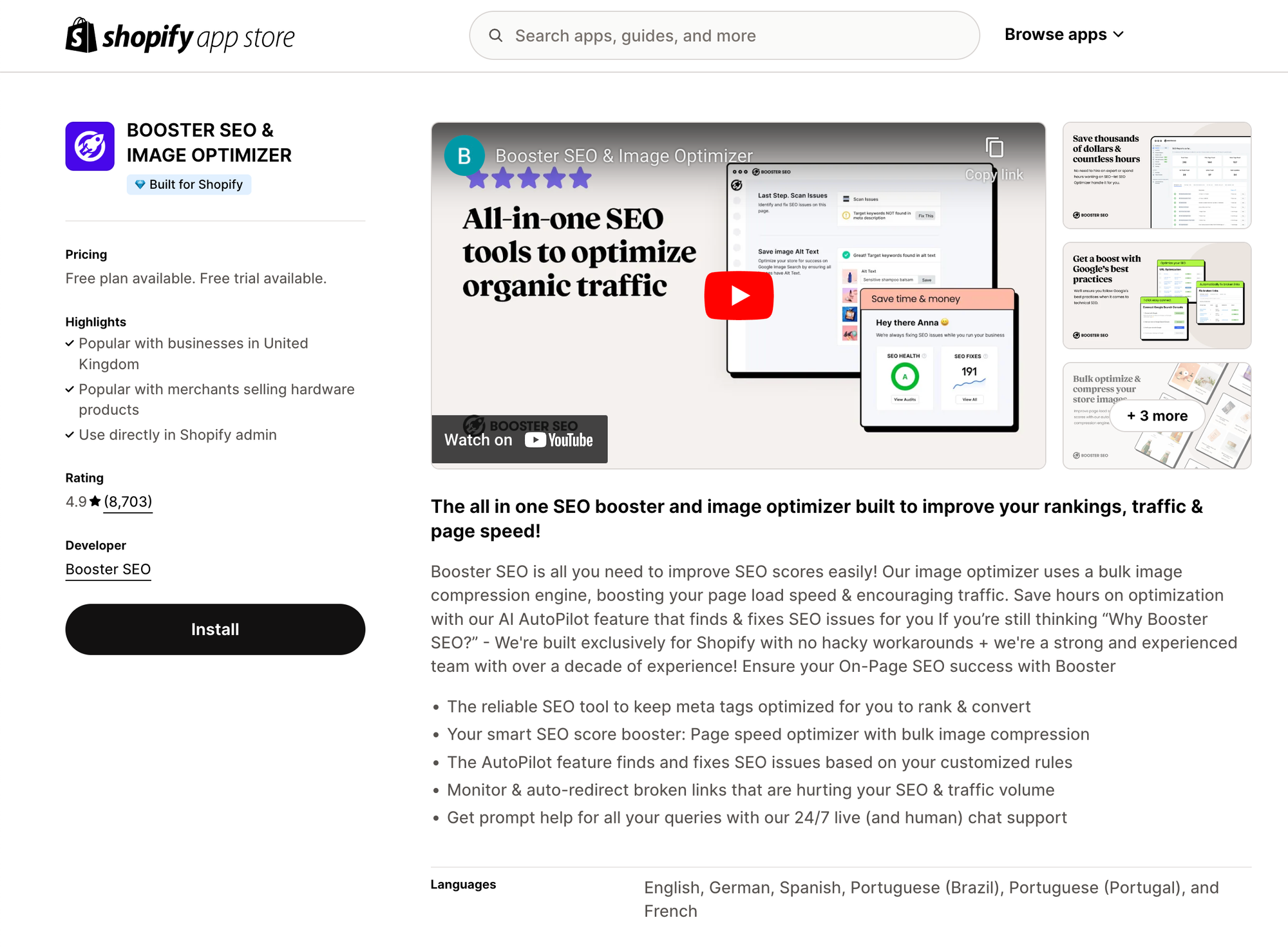
Built to improve on-page SEO and Shopify stores' technical SEO, the Booster app has a variety of impressive features, including:
- Meta tag optimization
- Smart SEO score booster to help optimize page speed
- Bulk image compression
- A monitor for broken links with an auto-redirect feature
What built-in SEO features does Shopify have?
As standard, your Shopify store has several built-in SEO features, such as:
- Automatic sitemaps and XML sitemaps
- URL structure optimization
- Meta tags support
- Canonical tags
- SSL certification
- Structured data
- Mobile friendly
- Automatically generated robot txt file
- 301 redirects
301 redirects are particularly important for improving user experience and boosting your SEO. If users head to a page URL that's broken, this can affect your bounce rate and send customers away.
Plus, search engines will notice that broken links are search results, which can affect your search engine ranking.
Don't forget to check out Shopify's variety of useful apps to help support you in various aspects of your SEO strategy.
Not sure that Shopify is for you? We've uncovered 10 of the best Shopify alternatives, including both paid and free options.
Step 8: Pay close attention to metadata and fields
Metadata is often overlooked. However, it is easily one of the most important elements of SEO for Shopify. Making these subtle alternations will help your store appear higher in search results — resulting in more organic traffic.
But there are a few things to bear in mind:
- Don't get carried away with stuffing your target keyword in at every opportunity, as this will damage your Shopify SEO efforts.
- Make sure your titles and descriptions are concise, they need to offer value and entice the reader without rambling on.
- Keep to 50-160 characters, any longer and it needs to be trimmed down.
- Meta fields for your products help you to both track your stock and display specialized information on the front end of your website. Make the most of these, such as part numbers, launch dates, related products and list of ingredients (where relevant).
Step 9: Avoid duplicate content and pages
This is often a common issue with ecommerce sites. One of the greatest things about Shopify is its 'collections' feature which helps to organize your products into categories.
However, this does mean that Shopify adds an extra URL. But how does that affect your SEO efforts?
Put simply, search engines could index the wrong page. This can be rectified, though! Firstly, to find duplicate content, try one of the following SEO tools:
- Semrush
- Siteliner
- Screaming frog
Once you've identified any duplicate content, all you need to do is remove this error by using canonical tags or redirects where relevant.
Canonical tags
Canonical tags let search engines know which page is preferred when there might be duplicated content. This will ensure that the parent page is the one that search results look to rank. Of course, not all duplicates are created equal.
While it's natural for some duplicates to appear, such as in the example above when using 'collections' — if you were to create several pages of the exact same content, featuring the same products, search engines could penalize you.
Step 10: Build authority with reviews
Take a look at ways to add reviews to your store. If you're a relatively new business, building trust with potential customers can make all the difference. Having reviews on your website can not only improve conversion rates, but with schema-enabled reviews, your product pages will likely rank higher in search results.
There is a variety of Shopify review apps available, such as:
- Judge.me [free and paid] — Easy to use with unlimited product reviews, even on their free plan.
- Loox Product Reviews [paid] — This app includes a handy social proof widget, as well as the ability to incentivize customers to leave a photo with their review by offering future discounts.
- Trustoo [free and paid] — Set up automatic review requests with this tool, add photos to reviews and even add a Q&A section to your product pages with Trustoo.
Here's how Dryrobe makes the most of reviews to build trust with customers.
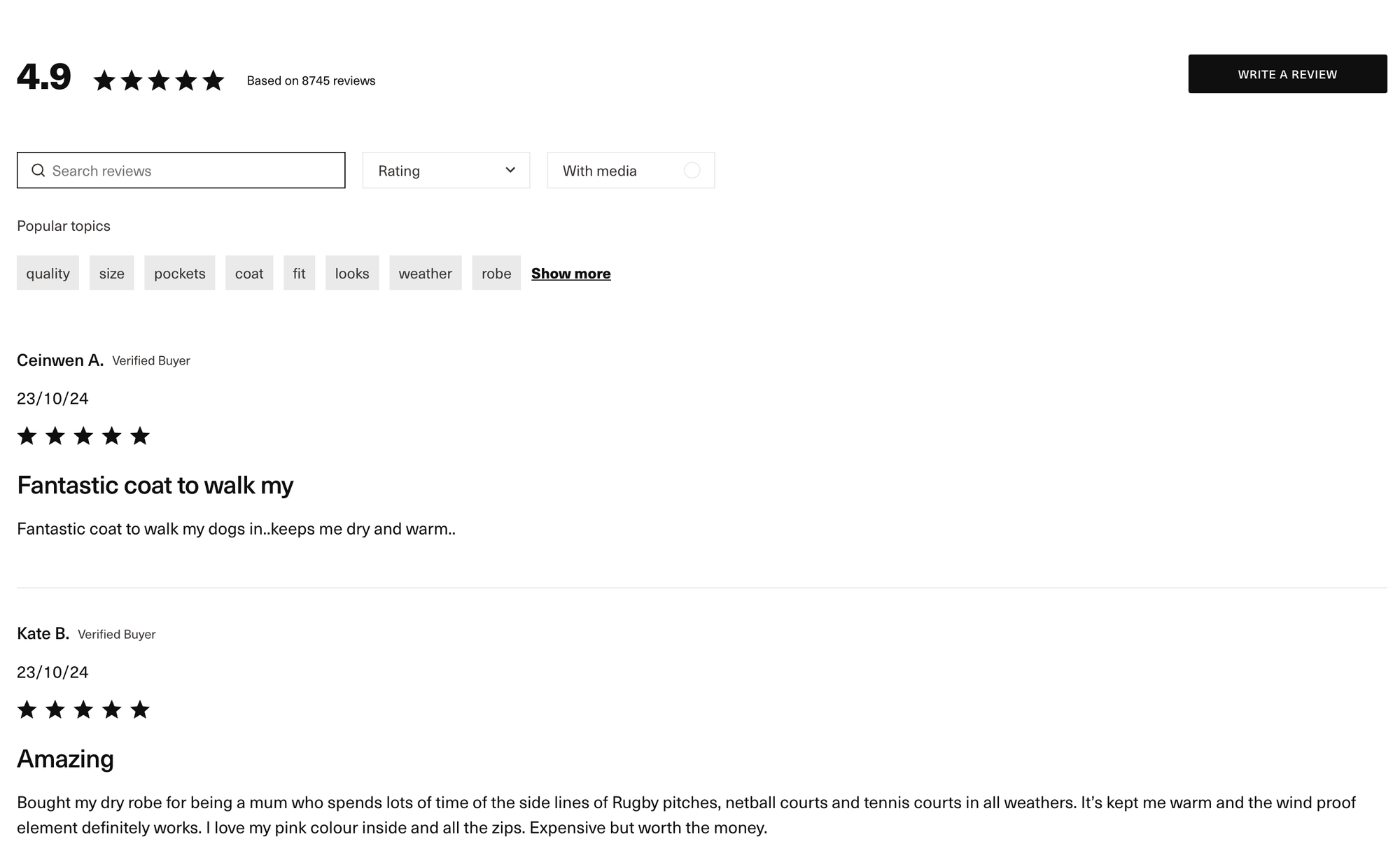
Why invest in Shopify SEO?
For ecommerce business owners, SEO is essential for showing up in Google and other search engines.
Shopify SEO can enable you to get more website traffic, which can lead to more customers – therefore sales. Although getting shoppers to your store can feel like the first hill to climb, it's important to do the groundwork to keep them on your website and encourage conversions.
Still not convinced? Here are a few more advantages of nailing your Shopify SEO:
SEO for Shopify, the main benefits:
- Can help you rank higher in search results, bringing more visibility to your products.
- Attracts more targeted traffic that is more likely to buy, also reducing bounce rate.
- Helps you to build trust with potential customers, when your website shows up in search results.
- Encourages link building, helping your brand get seen by readers on external websites.
Learn more and expand your skills with Whop
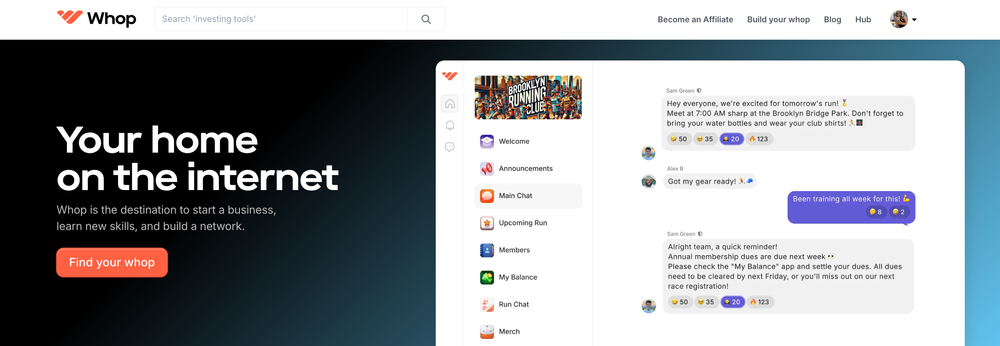
Ready to optimize your off and on-page SEO? From optimizing internal linking to crafting page titles that convert, Whop has it all.
Discover everything you need to know about SEO for Shopify in our guide above, and learn even more from Whop communities. Whop is home to communities and courses that teach you the art of marketing - including SEO strategy.
Head to Whop and find a course, community (or both!) and watch your business thrive.





